30
Architecture in focus
Dr. Evan Freeman
*
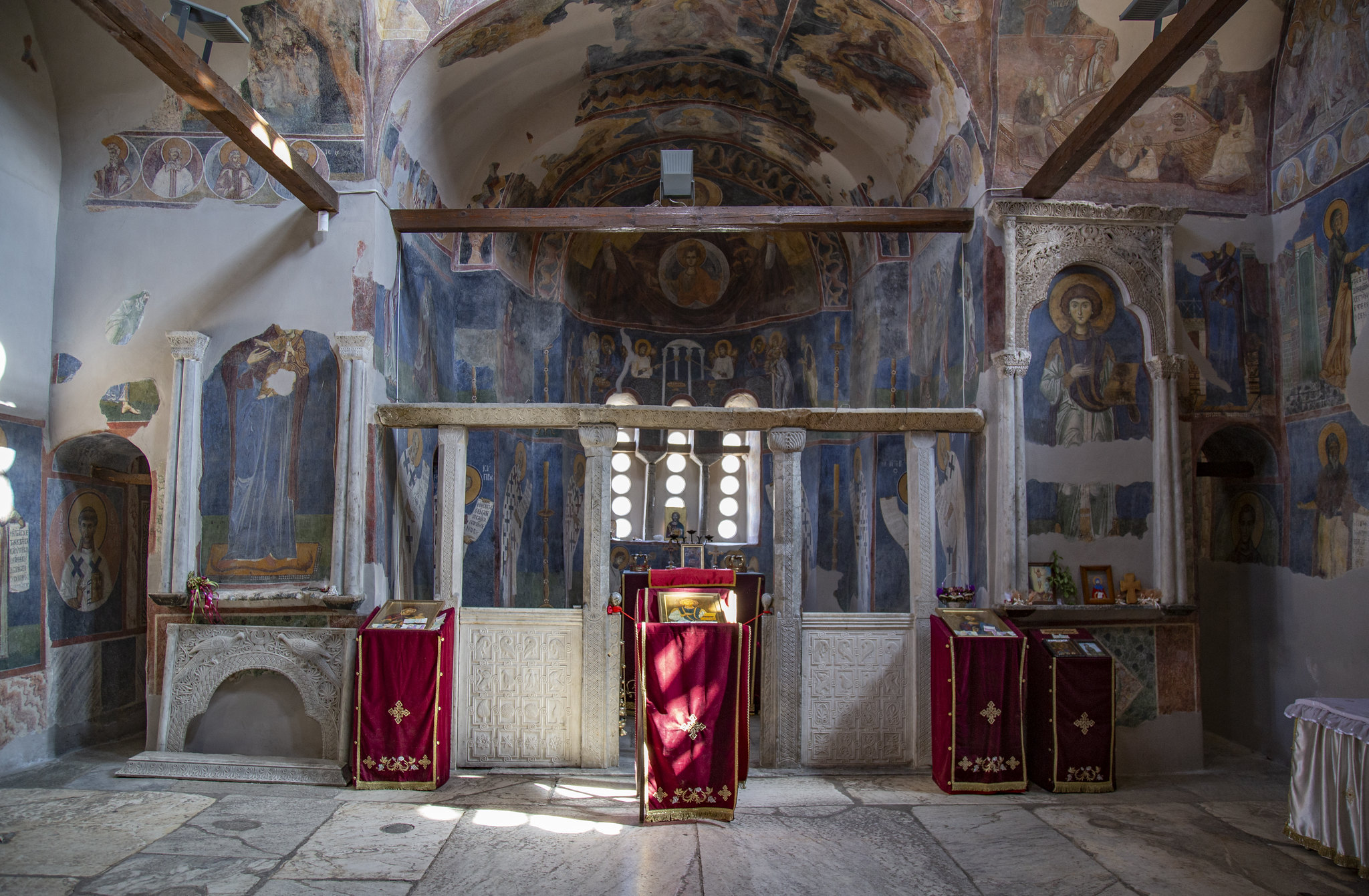
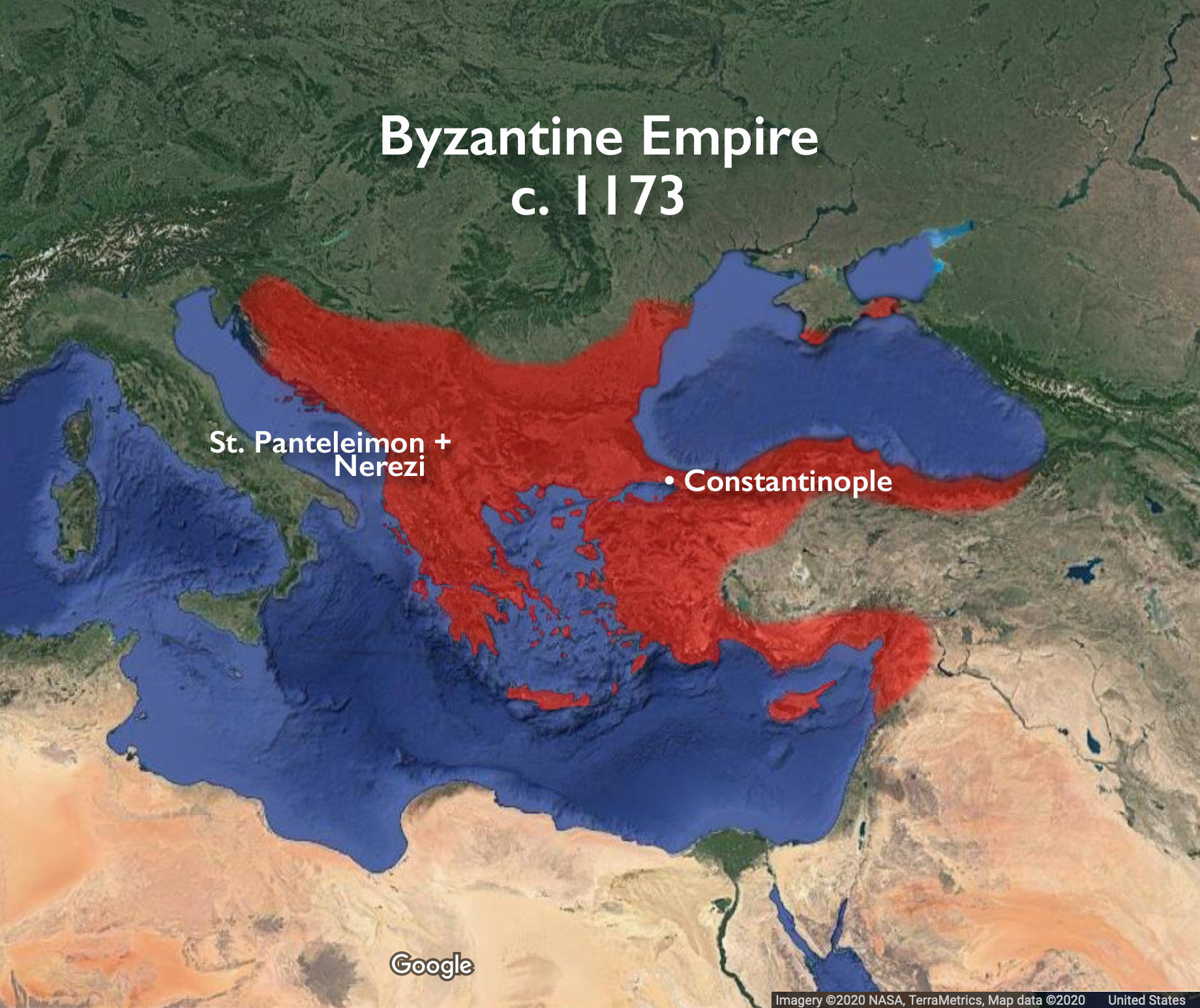
*
Imperial Patronage
According to a painted inscription in the church, the Middle Byzantine church of Saint Panteleimon (pronounced pan-tah-LAY-mon) was built as a monastery church in 1164 by Alexios Komnenos, a nephew of Byzantine emperor John II. Alexios may have owned land in this region. Nerezi’s five-domed architecture and high-quality frescoes reflect its imperial patronage.
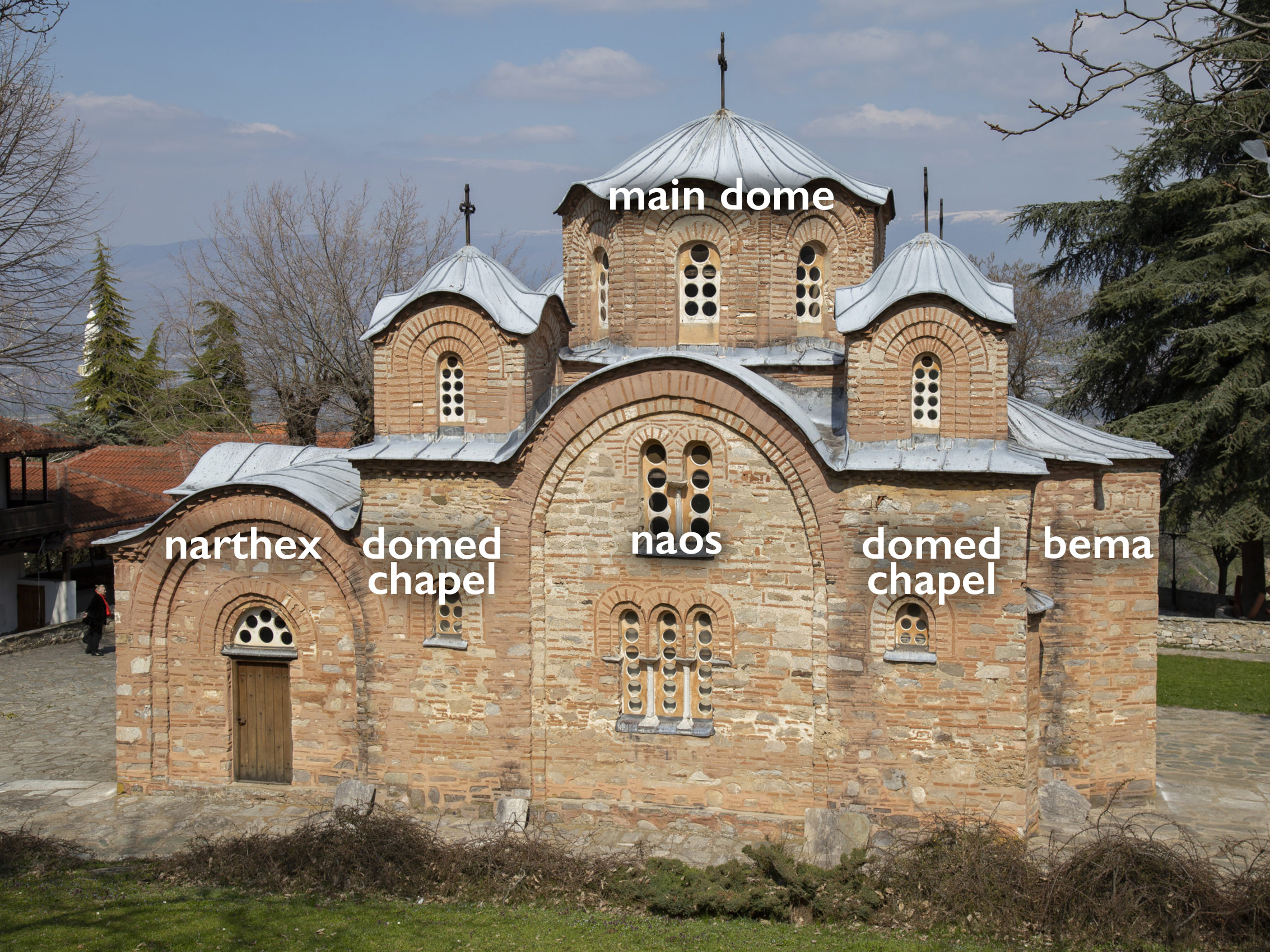
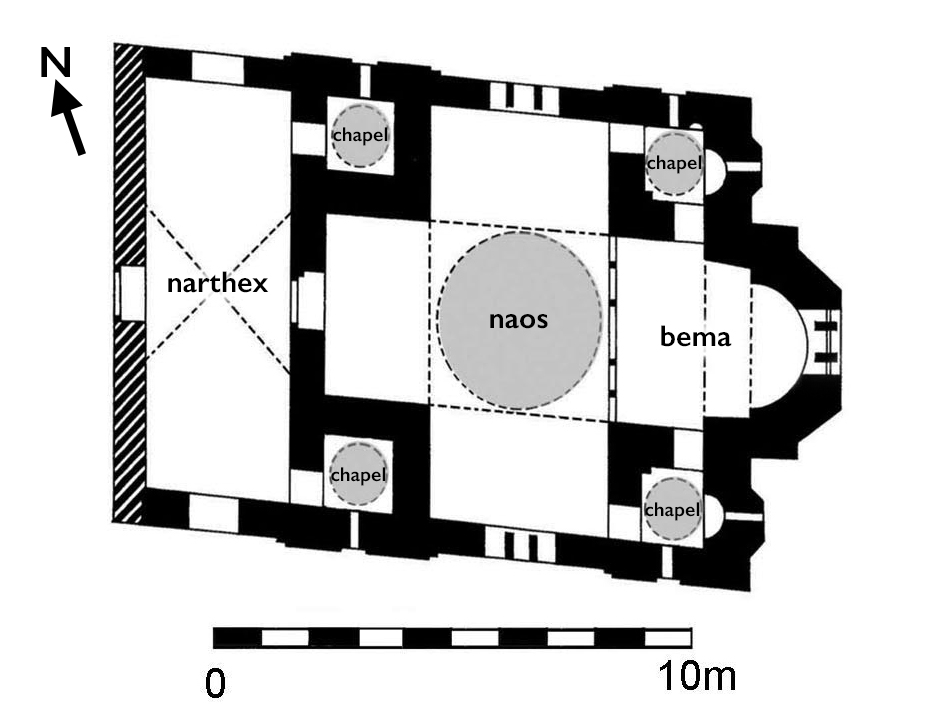
*
Architecture
Saint Panteleimon is a modest, cross-domed structure (its central dome is braced on four sides by vaults in the shape of a cross) with four smaller domed chapels, making it a five-domed church. Its five-domed design echoes the form of the church of the Holy Apostles in the Byzantine capital of Constantinople (destroyed following the Ottoman conquest of Constantinople in 1453)—which contained relics (remains) of the Apostles and the tombs of Byzantine emperors—reflecting Nerezi’s connections with the capital and imperial family.
Like most Byzantine churches, Saint Panteleimon is divided into three main parts, which were adorned with frescoes:
- the narthex at the western end of the church, which functioned as an entrance vestibule;
- the naos—the main part of the church—where most of the worshippers attended church services; and
- the bema, or sanctuary, where the altar was located and where the clergy led the celebration of the Eucharist.
The two eastern chapels connect to the bema, enabling them to function as a prothesis and diakonikon. The two western chapels connect with the narthex and may have been used for services that took place in the narthex. (The “prothesis” was a chamber often located to the north of the altar where the bread and wine could be prepared for the celebration of the Eucharist and sacred vessels could be stored; the “diakonikon” was a chamber often located to the south of the altar where vestments and other church objects could be stored.)
Frescoes
While the frescoes in the narthex have been badly damaged and the upper portions of the naos and bema were replaced with post-Byzantine paintings, the naos and bema preserve much of the original, twelfth-century frescoes on the lower levels.
A stunning, blue background unifies the original, twelfth-century frescoes, which have been executed with a range of vivid colors. The figures at Nerezi are slender and often elongated. Nerezi’s painters have made extensive use of lines to define the boundaries of shapes, model forms, and portray emotions in the individualized faces of many of Nerezi’s figures. This elongation of the figures and repetition of lines create a sense of visual rhythms and movement within the church, and were a hallmark of Byzantine painting during the Komnenian period.
The high quality of Nerezi’s frescoes and similarities with other artworks have led many scholars to conclude that the church’s painters hailed from the Byzantine capital of Constantinople, a major center of artistic patronage and production. Nerezi’s frescoes are particularly valuable since no painted church programs from Constantinople survive from this period (much of Constantinople’s church art was destroyed following the Ottoman conquest of the city in 1453).
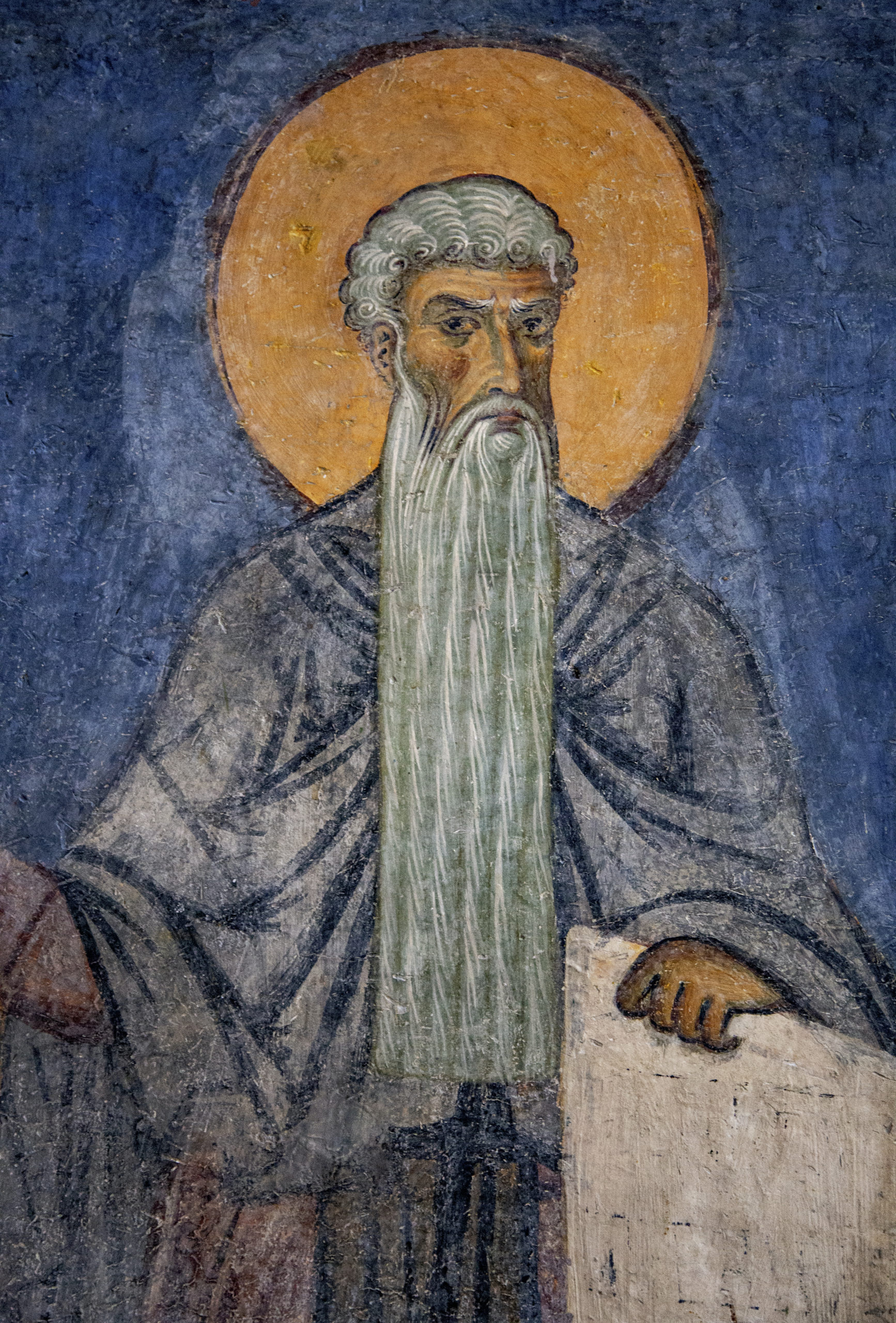
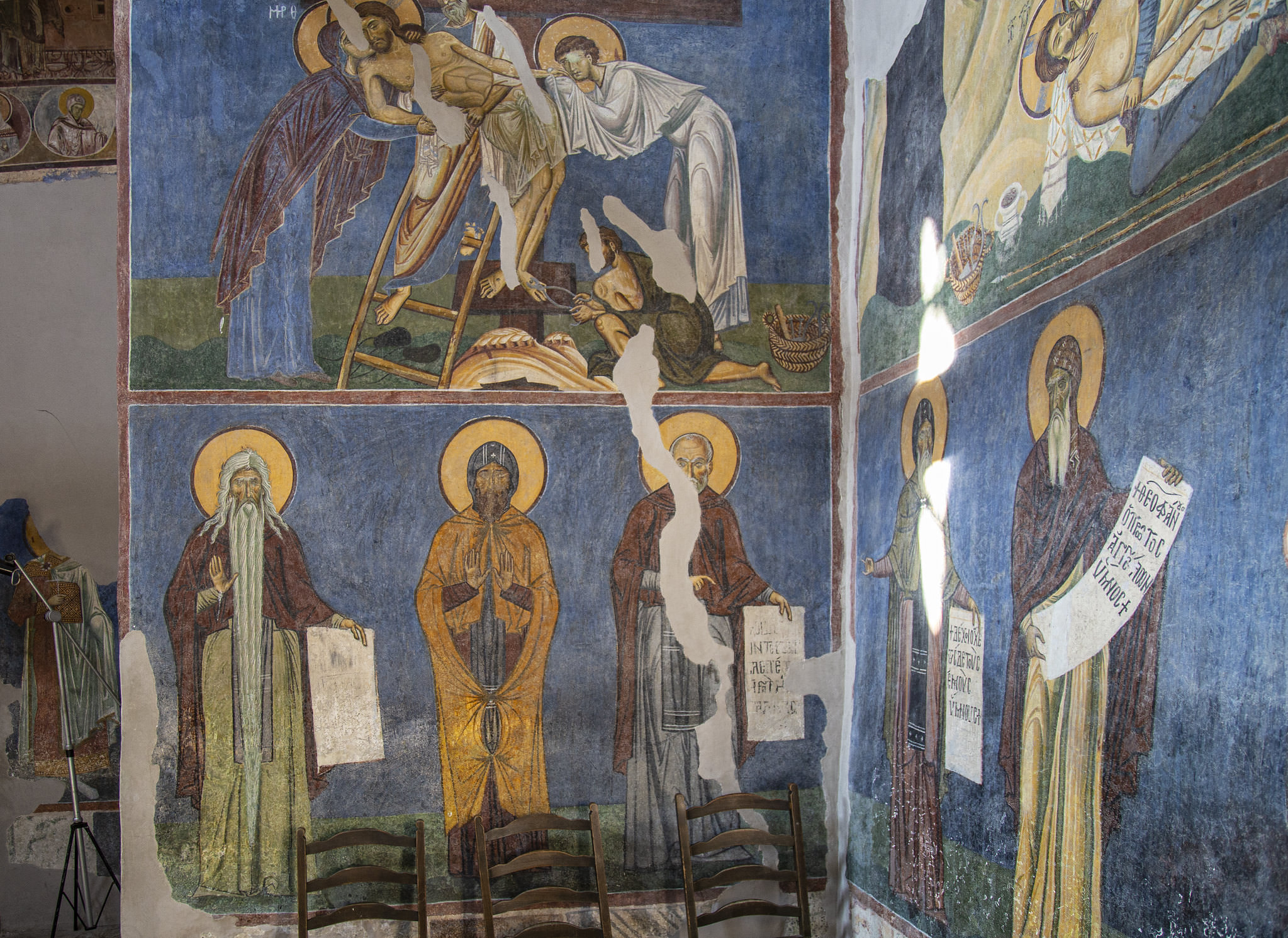
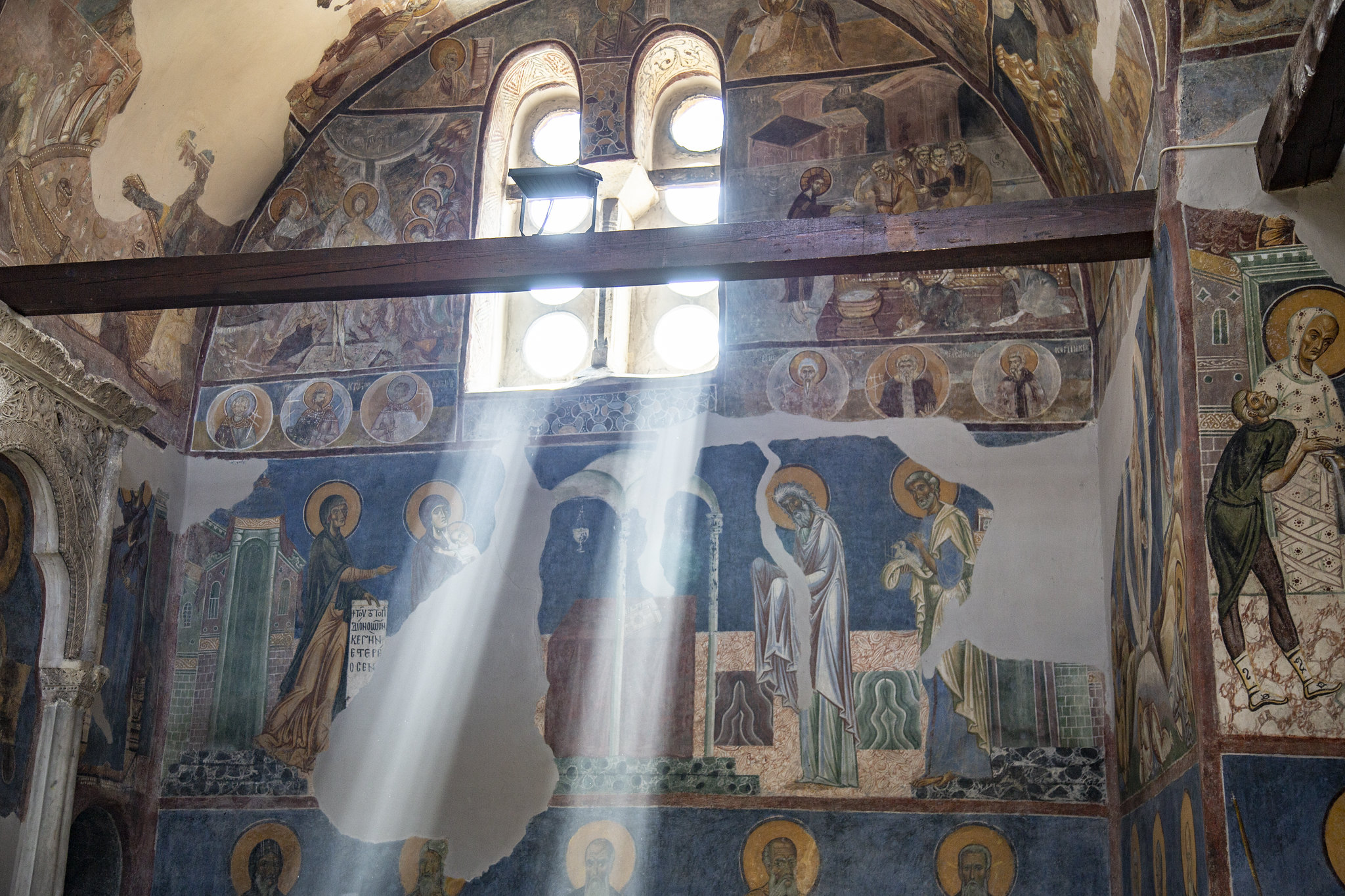
*
The Naos
As was common in post-Iconoclastic churches, Nerezi features full-length, nearly life-size portraits of saints at the floor level, with narrative scenes from the lives of Christ and the Virgin Mary above.
The Meeting of the Lord in the Temple
This narrative cycle begins on the southern crossarm of the naos, which is dominated by a large image of the Meeting of the Lord in the Temple. Here, Mary and Joseph bring the newborn Jesus into the Jewish temple and the prophets Simeon and Anna identify him as the Messiah.
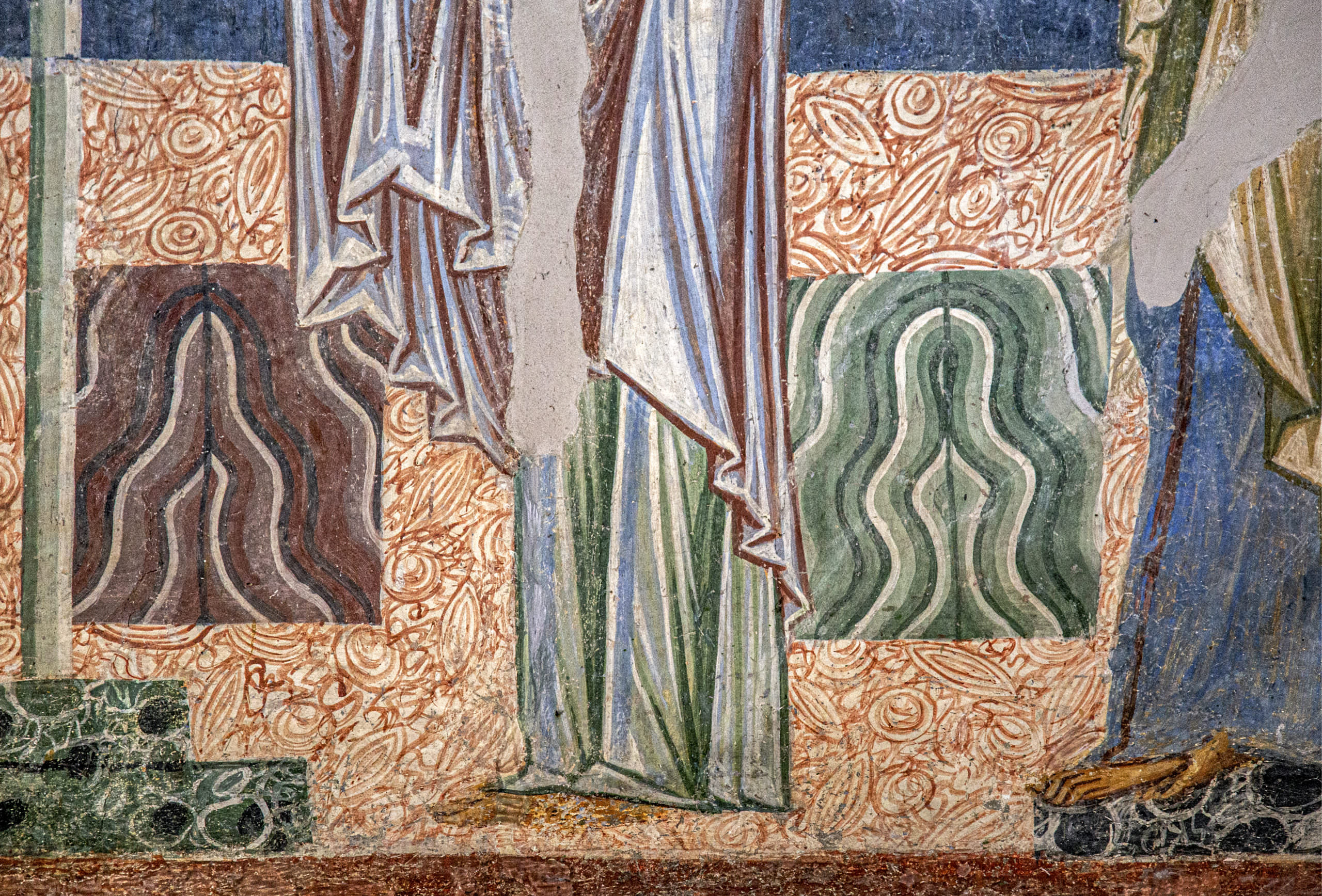
The artists have imagined the interior of the temple as a Christian church with an altar, ciborium (a canopy raised above an altar, throne, or tomb, also called a baldachin), and marble revetment, including bookmatched marble slabs like those found in Justinian’s sixth-century Hagia Sophia and other Byzantine churches. (The Byzantines often matched marble slabs so they appeared to mirror each other, a technique known as “bookmatching,” since it created the appearance of an open book.)
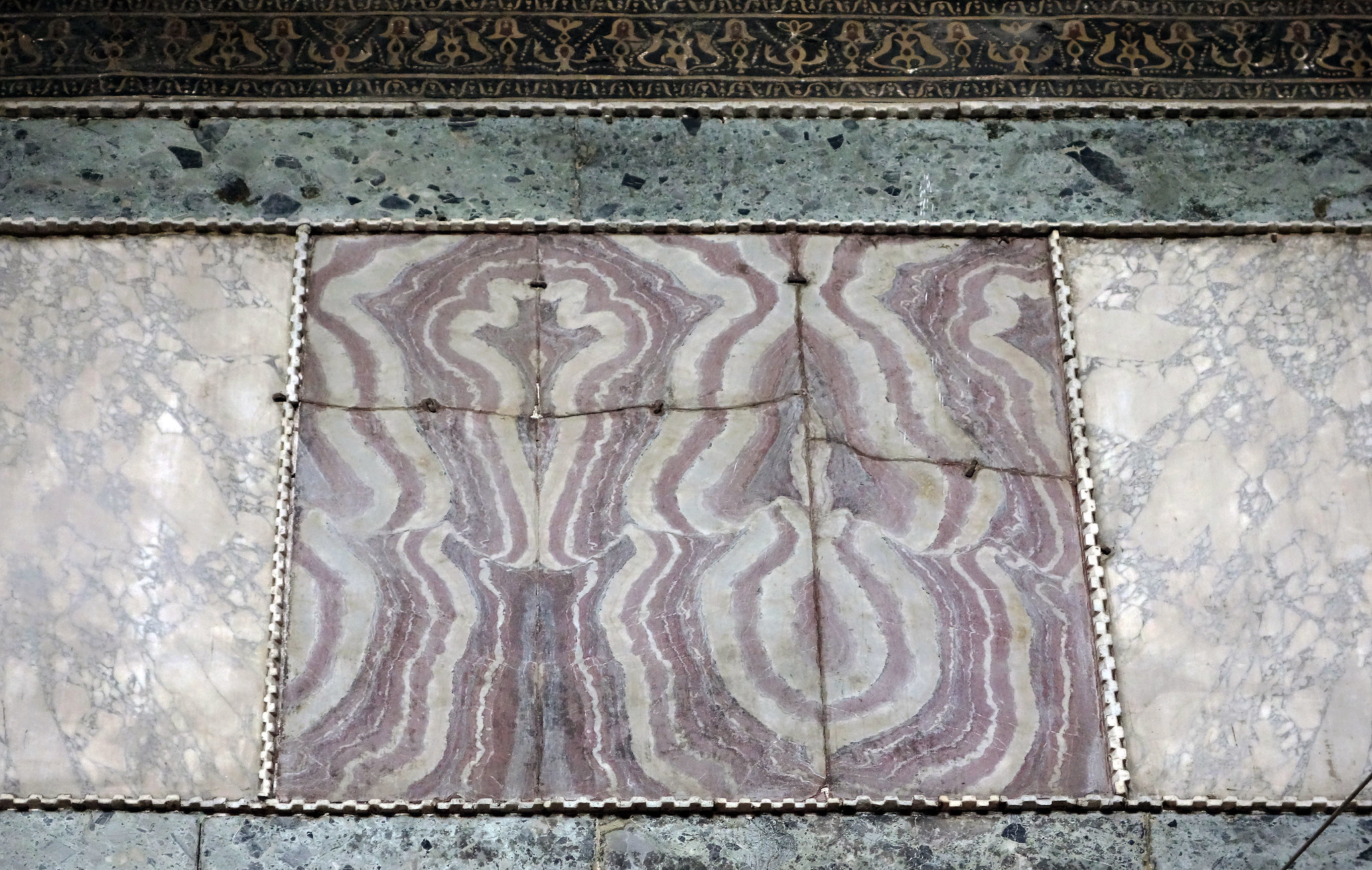
The Deposition
Christ’s followers mourn his death on the north side of the naos, a common theme of hymns and sermons during the post-Iconoclastic era. In the Deposition, Christ’s followers remove his body from the cross. Joseph of Arimathea looks out at the viewer with a piercing gaze from the center of the scene.
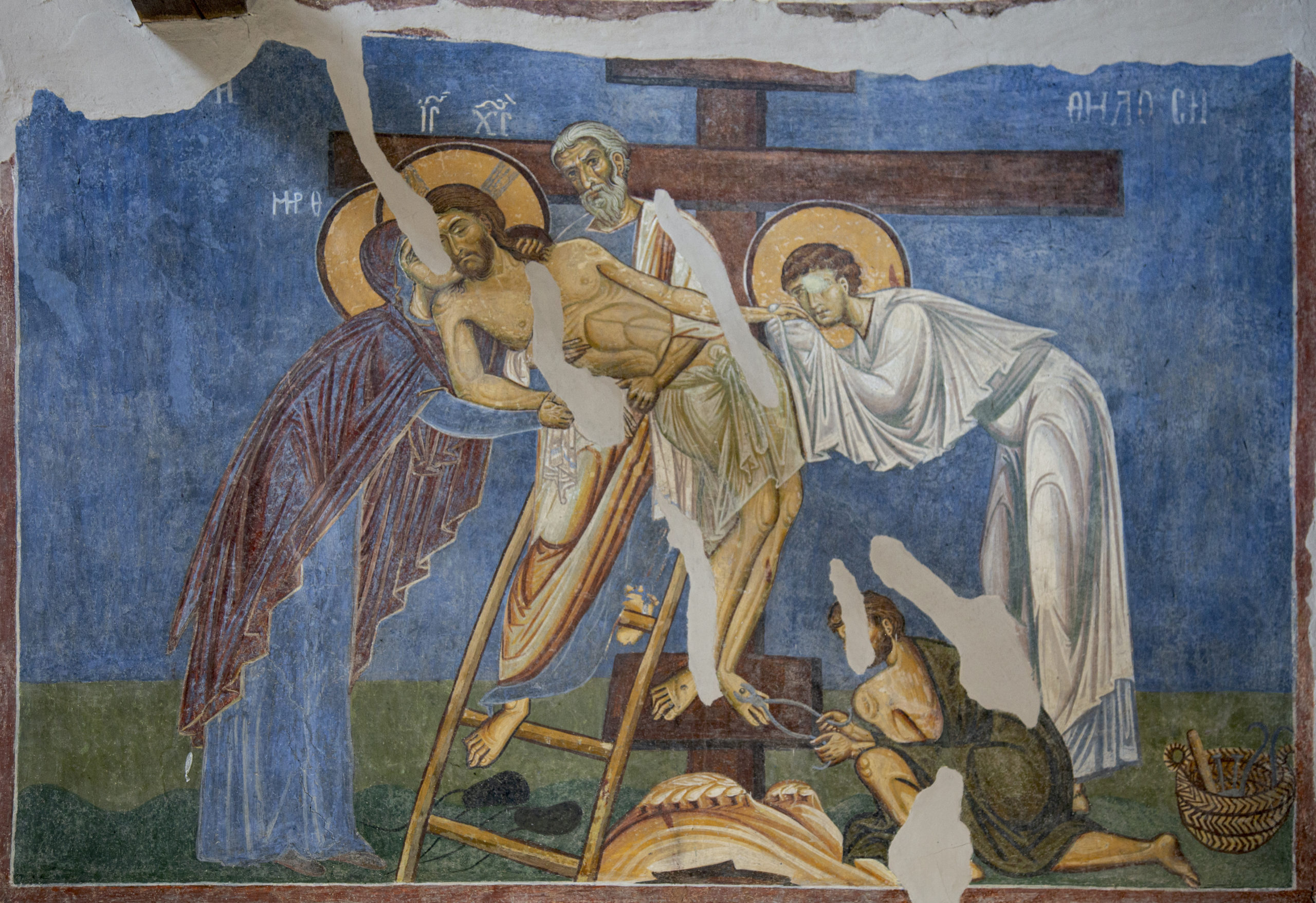
The Lamentation
The narrative continues with the Threnos, or Lamentation, located next to the Deposition. The dead Christ now lies on the ground but has not yet been placed in the tomb (which appears on the left side of the image). Christ’s followers mourn his death. Lines of grief crease their faces, creating emotional expressions often absent from Byzantine art. The Virgin cradles her dead son in her lap, recalling how she carried him into the temple in the Meeting of the Lord on the opposite wall.
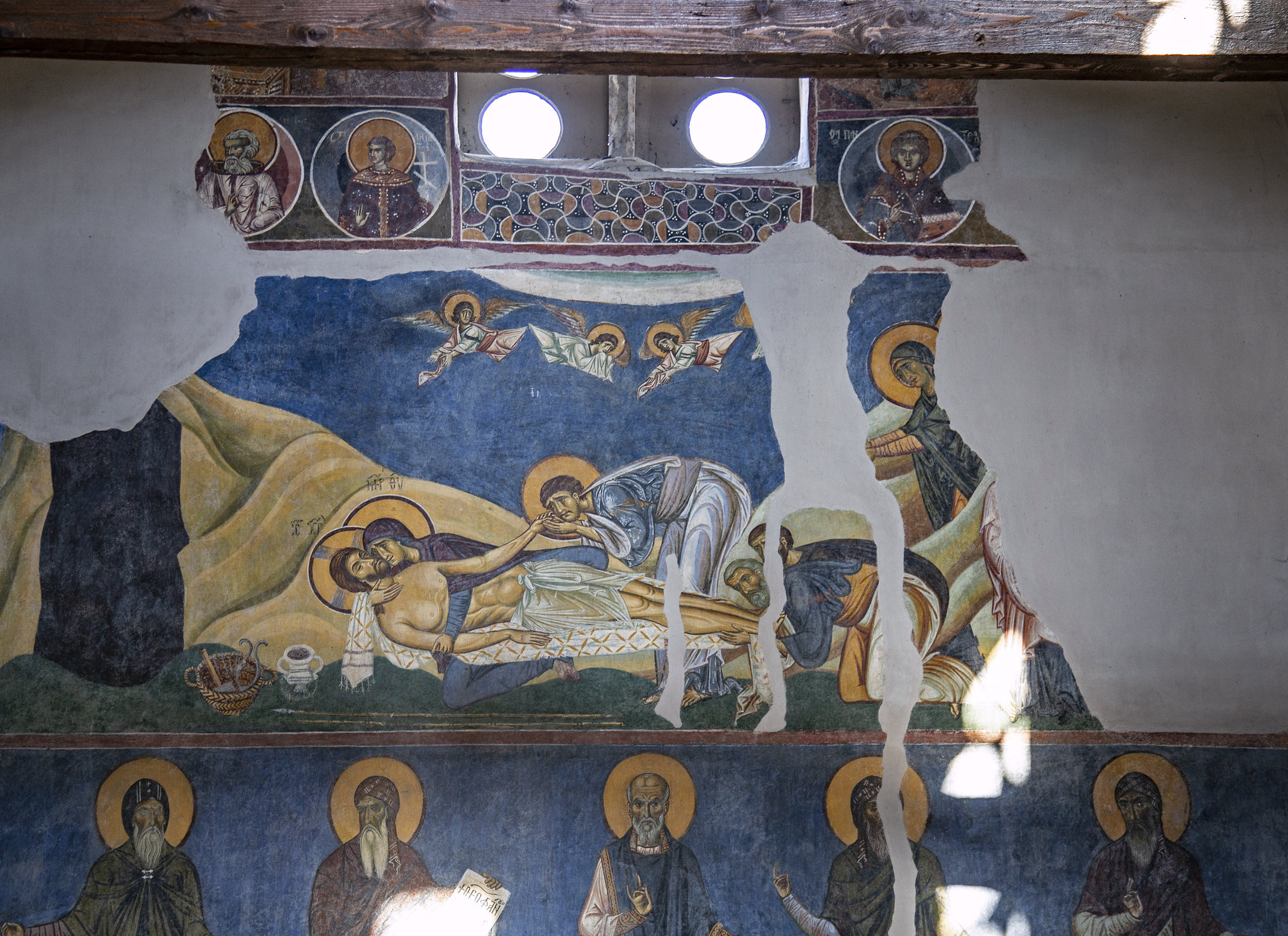
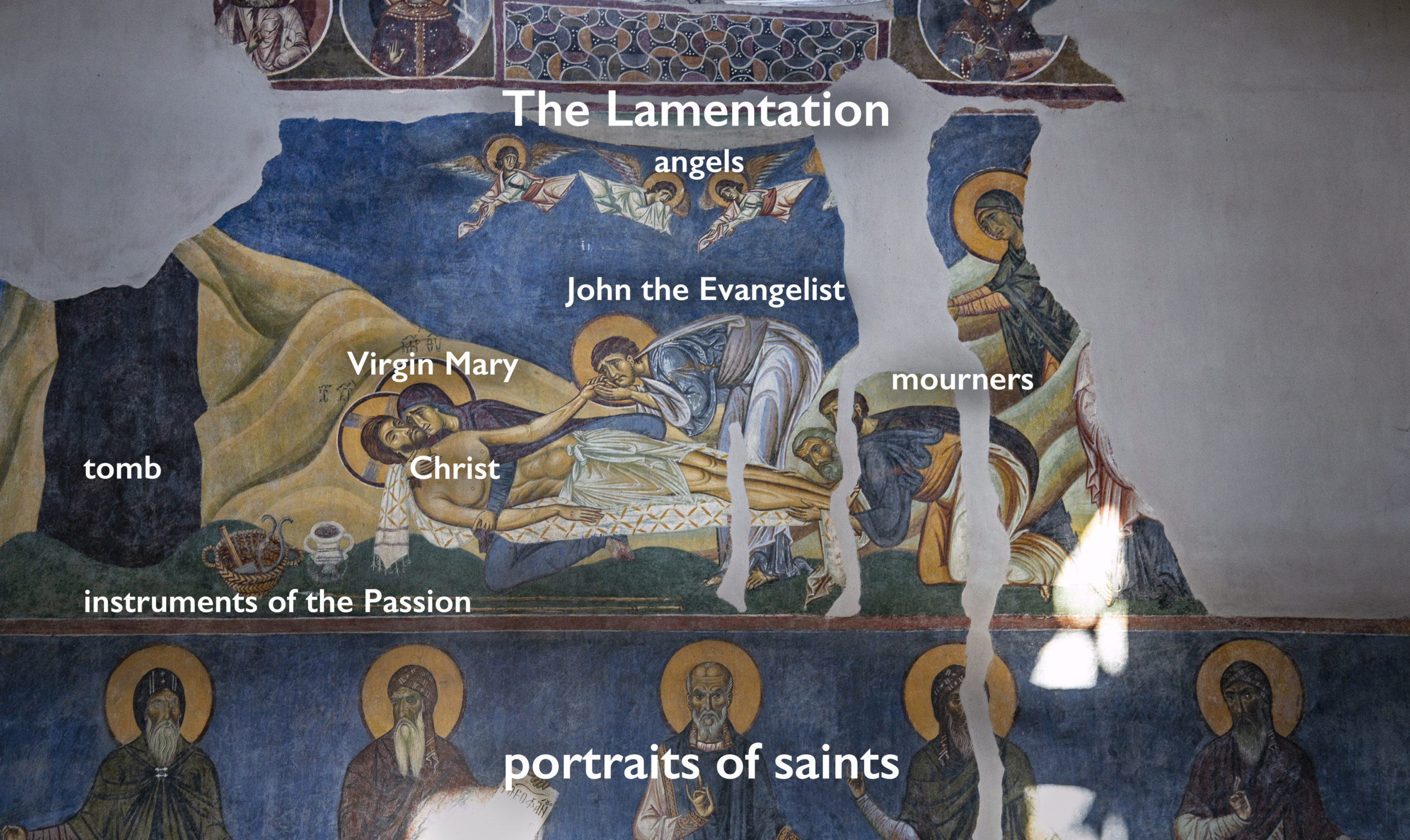
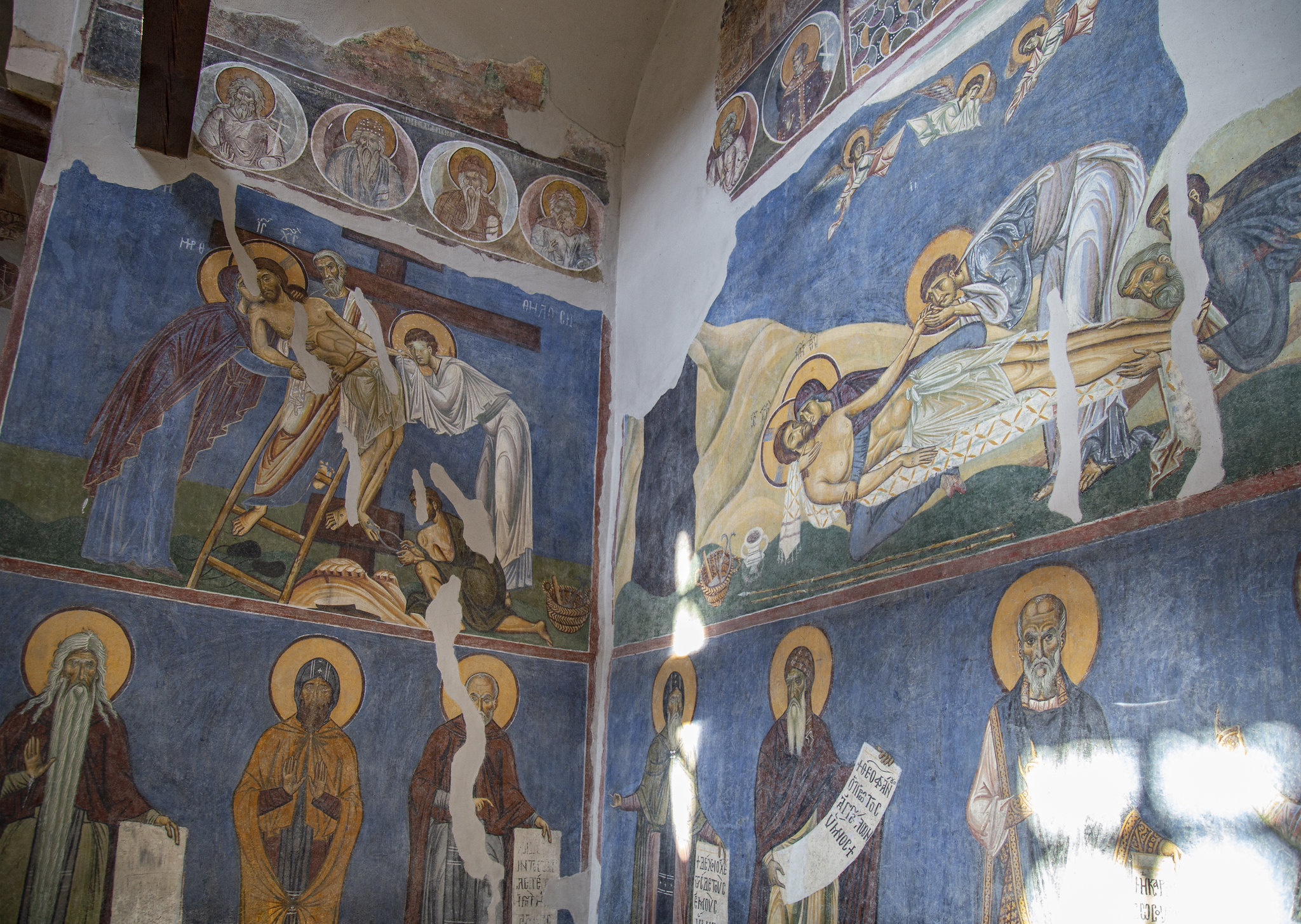
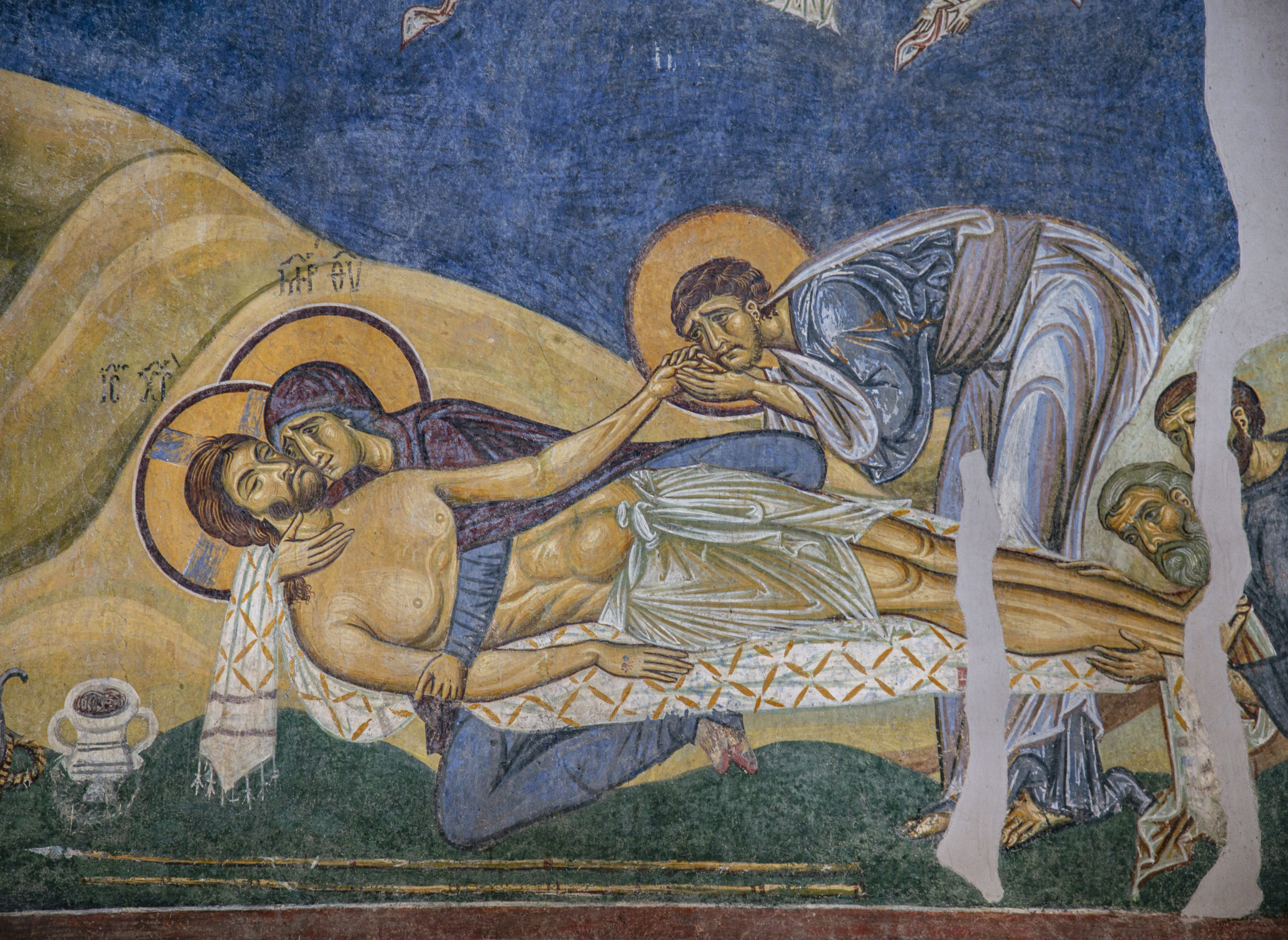
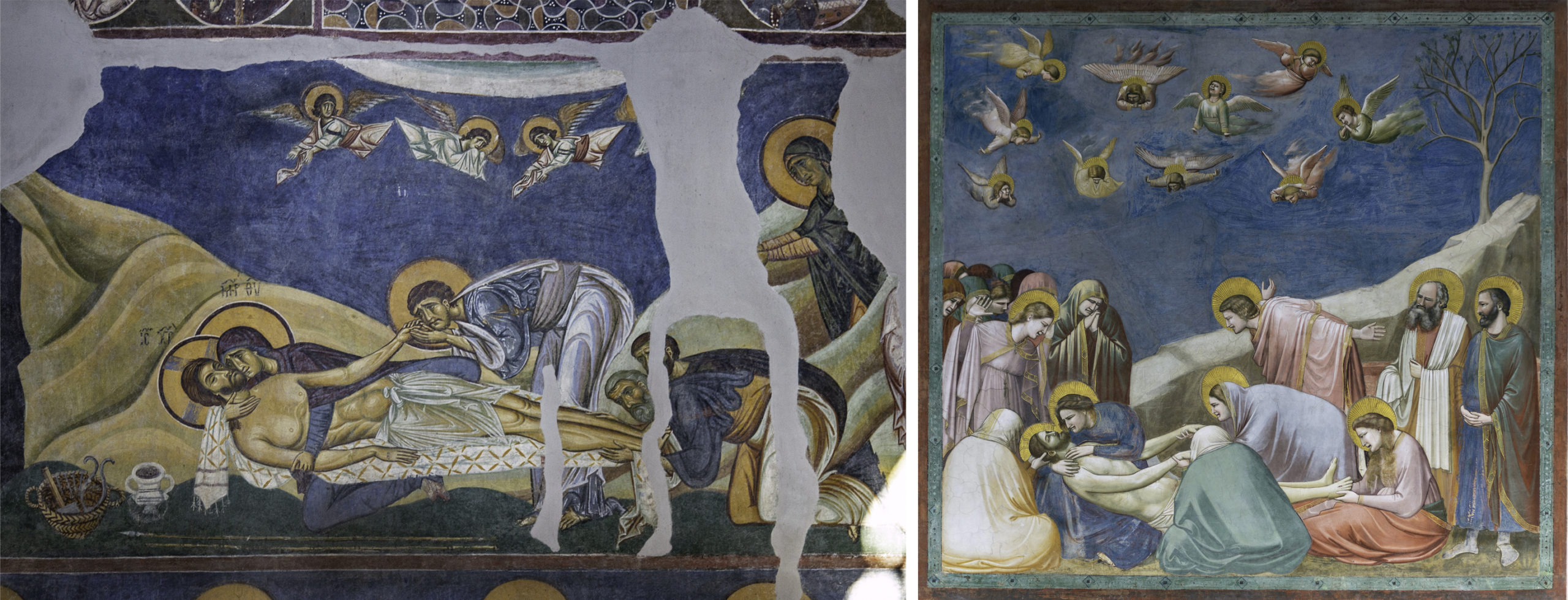
In Byzantine mosaics and panel paintings, such scenes often appeared against a solid gold background. Yet here, the artist has effectively employed fresco to create a naturalistic environment: an undulating green ground, tan hills with rhythmic curves, and a deep blue sky. This landscape also serves the larger composition; the silhouettes of the hills sink toward the center of the scene, moving the viewer’s eyes to the figures, and heightening the overall drama of the image.
This scene, its naturalistic setting, and its emphasis on emotion all anticipate developments associated with Renaissance Italy. Scholars have noted the striking similarities between Nerezi and Giotto’s fourteenth-century frescoes at the Arena Chapel in Padua, Italy, particularly in Giotto’s own rendition of this same scene: The Lamentation. Although Giotto’s figures are more naturalistic than those at Nerezi, both frescoes emphasize the mourners’ grief within a landscape that amplifies the drama of the scene.
The Templon
A templon separates the naos (where most worshippers stood) from the bema (where the clergy stood around the altar), reconstructed from twelfth-century fragments (view location in plan below). This form of sanctuary barrier, consisting of chancel slabs, colonnettes, and an epistyle or templon beam, was widespread in Byzantium during this time, and enabled laypeople to see into the bema. Later, Byzantine templons incorporated intercolumnar icons (as seen at the fourteenth-century church of Saint George of Staro Nagoričino) creating what has become known as an “iconostasis,” which can still be found in Orthodox churches today.
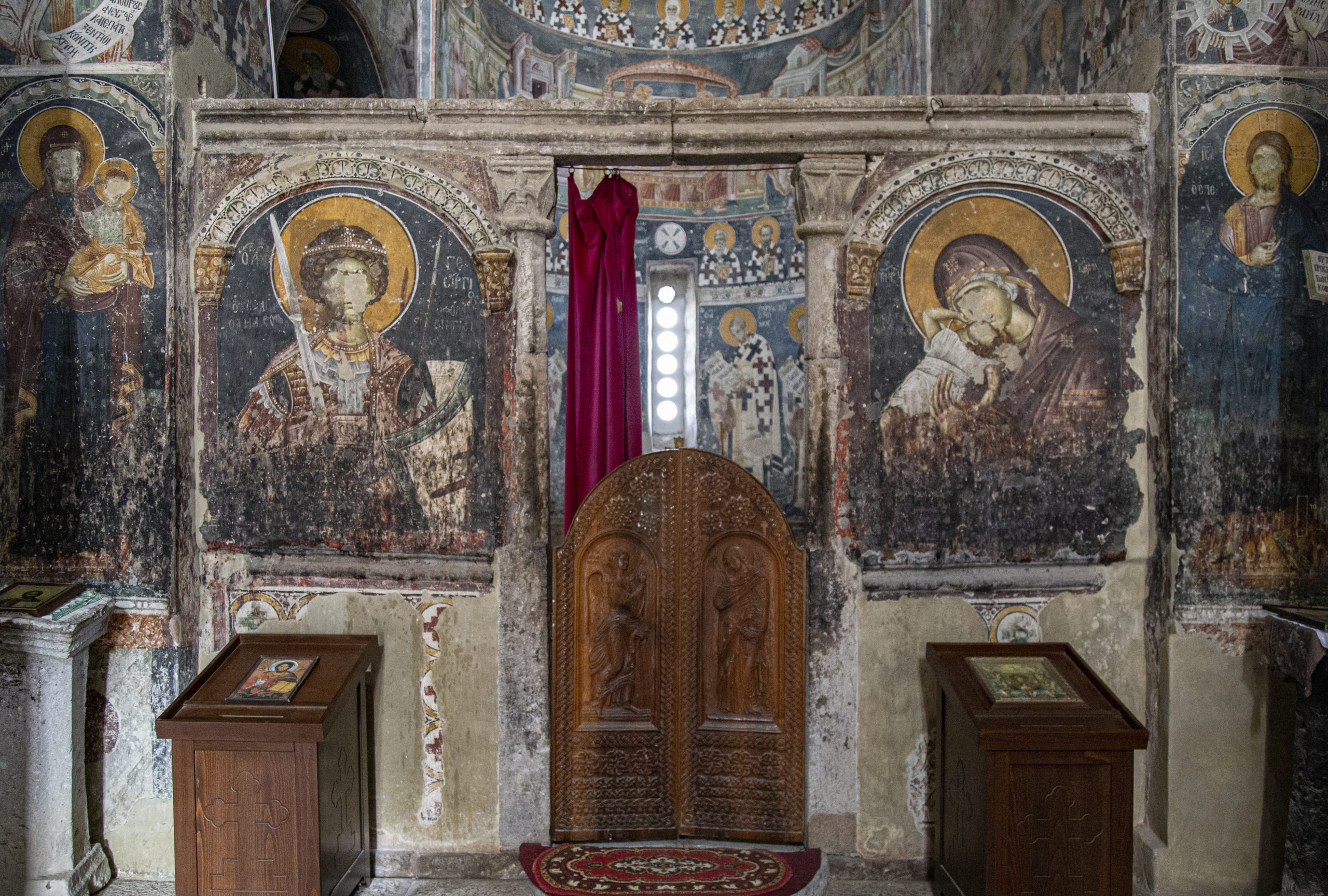
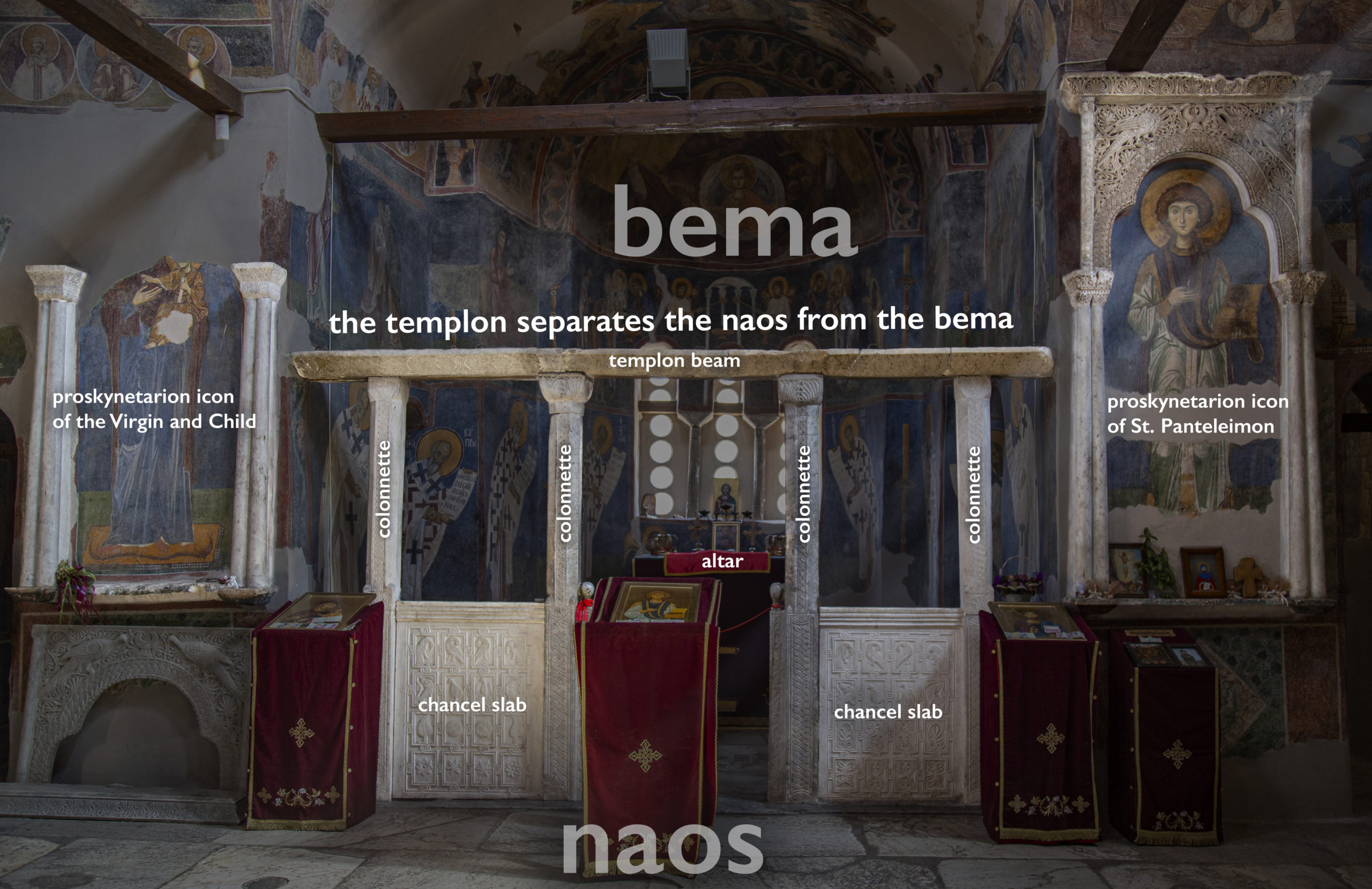
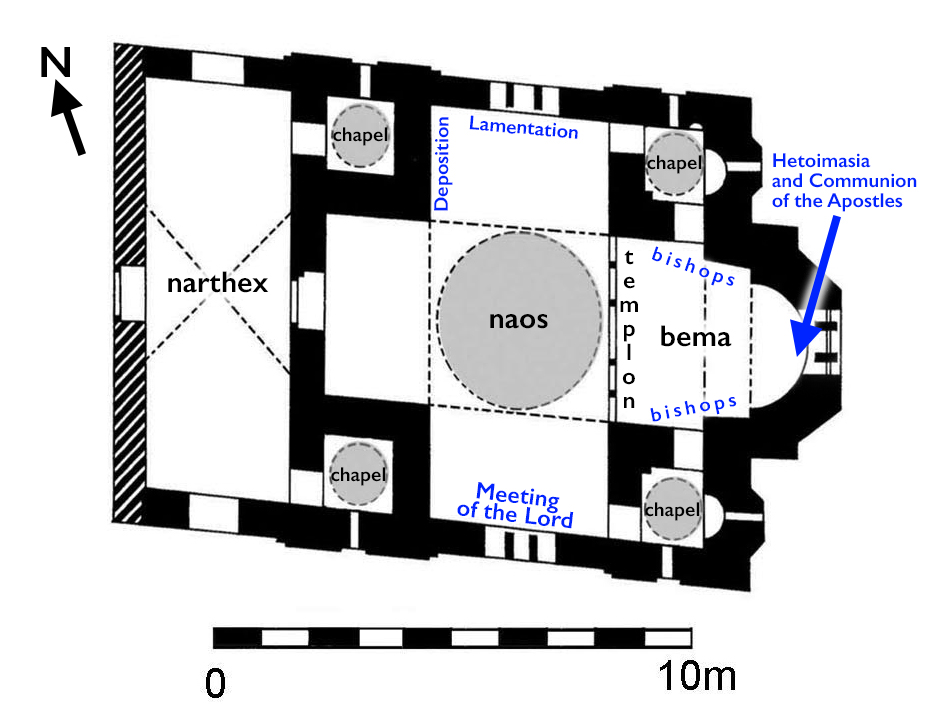
Proskynetaria icons
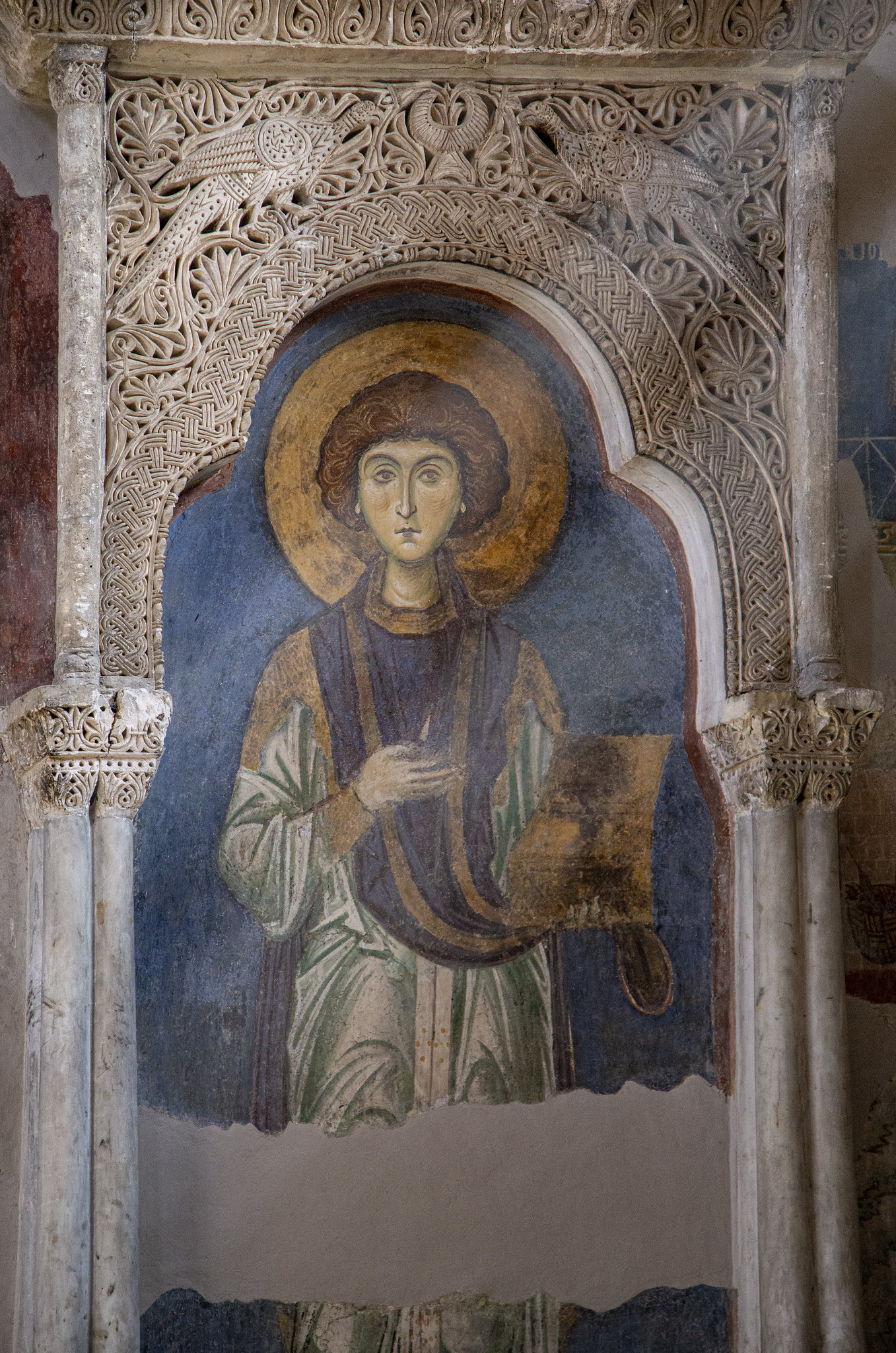
As was common in Middle Byzantine churches, the church of Saint Panteleimon features two large proskynetaria icons on either side of the templon. The damaged icon to the north once depicted the Virgin and child, resonating with the narrative depictions of these figures in such scenes as the Meeting of the Lord and the Lamentation. The icon to the south represents Saint Panteleimon, a healer who was the church’s patron saint. Panteleimon retains his original stuccoframe, which features delicately carved birds and vegetal motifs. The large scale, prominent position, and elaborate frames of these proskynetaria icons must have made them a focus of prayer and veneration for Byzantine worshippers.
Bishops in the Bema
The bema, where the clergy celebrated the Eucharist, displays images that reflect the ritual function of this particular space. Eight bishop saints decorate the bema walls at ground level, two of whom appear to emerge from the side chapels. Images of bishops were a common feature in Byzantine bemas for centuries, where they were usually depicted frontally and holding books, as at the sixth-century church of Sant’Apollinare in Classe, near Ravenna, Italy.
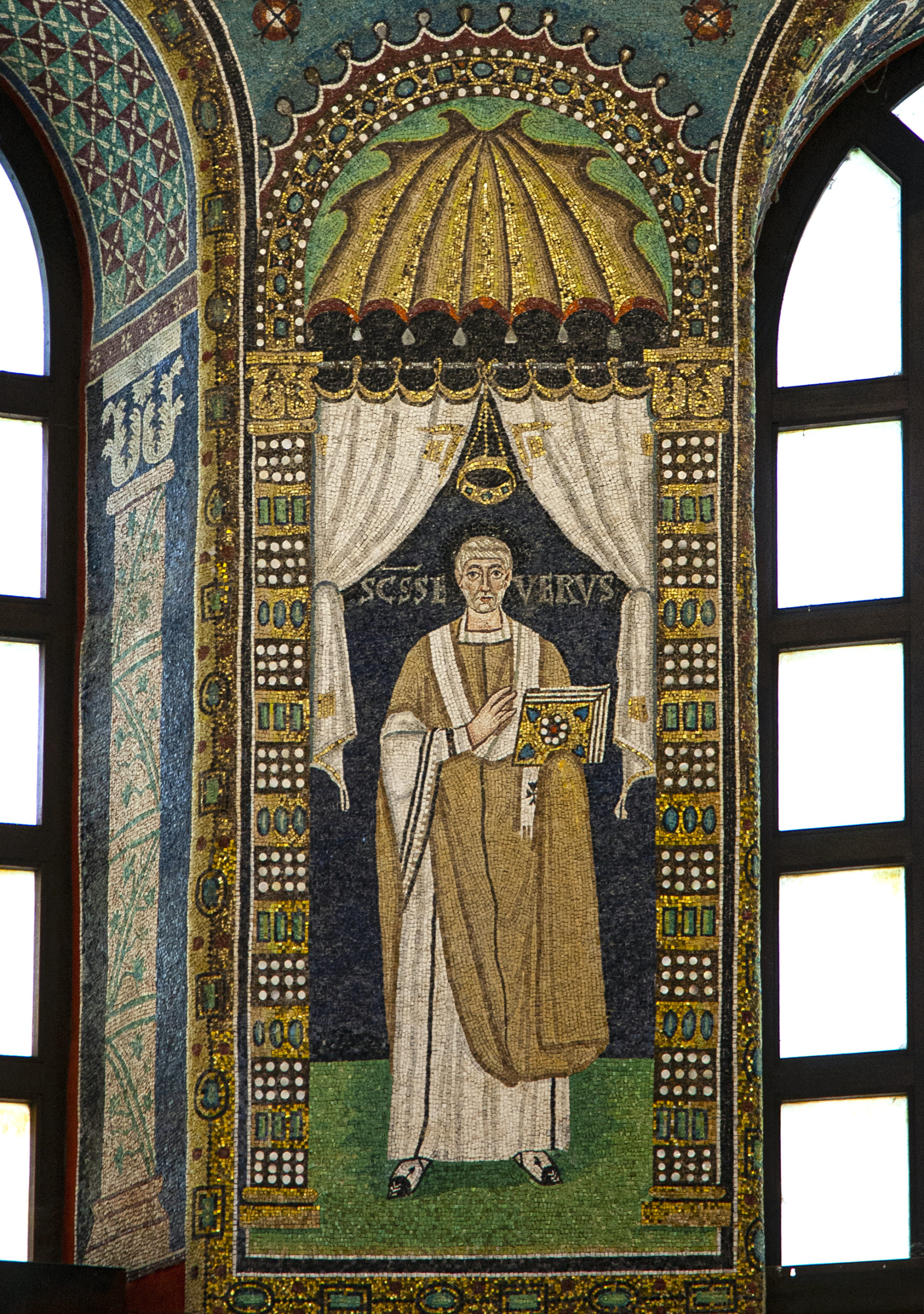
But the bishops at Nerezi appear in a three-quarter view and strike a more dynamic pose, an innovative approach at this time. Instead of closed books, the bishops at Nerezi hold unfurled scrolls (or “rolls”) that display prayers spoken by the clergy in the Divine Liturgy. Such scrolls were actually used by clergy during this period, as seen in a roughly contemporary, twelfth-century example preserved at the British Library. This new way of depicting bishops in a three-quarter pose and accompanied by contemporary liturgical objects made these saints appear as active participants in the church services celebrated in this space.
In the apse behind the altar, two angels vested as deacons hold liturgical fans (another contemporary liturgical object) on either side of the Hetoimasia, or “prepared throne,” a symbolic image that evoked Christ’s Passion and anticipated second coming. Additional angel deacons appear above, where Christ is shown giving Eucharistic bread and wine to his Apostles like a priest, mirroring the Divine Liturgy as it unfolded below.
Scholars refer to this tendency of church art to illustrate contemporary ritual and material culture during this period as “liturgical realism.”
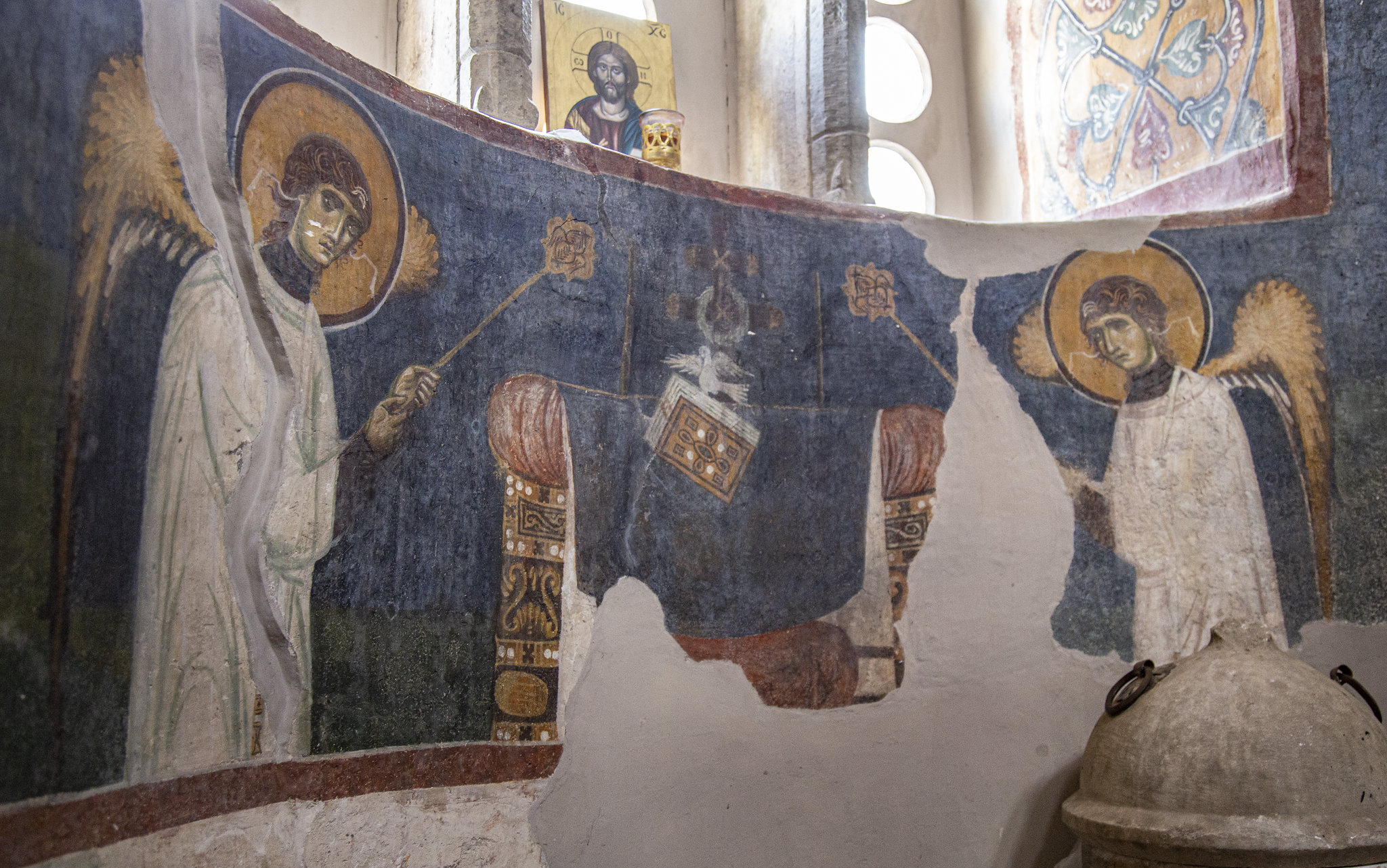
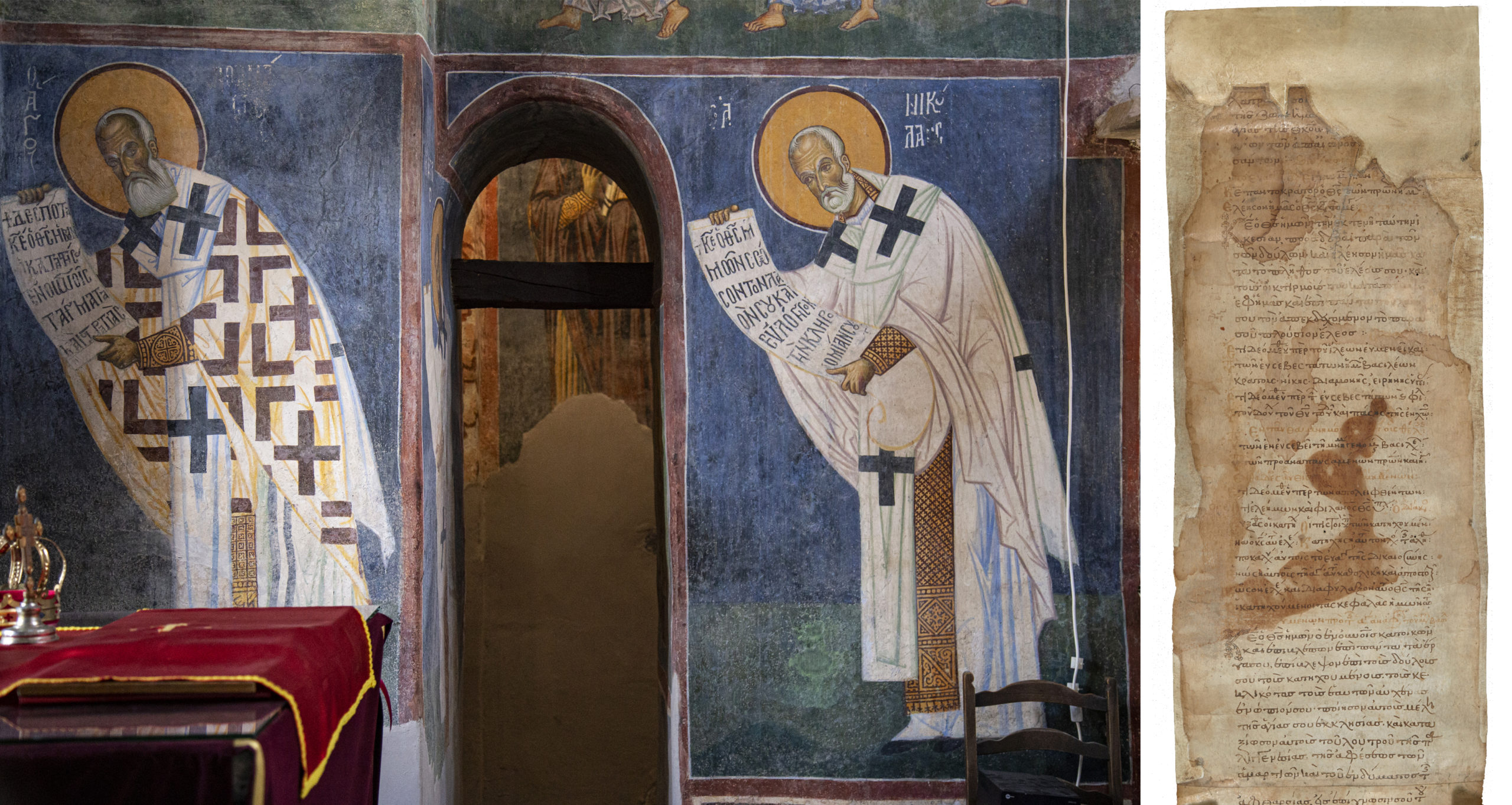

Nerezi in art history
Byzantine art may be known for its golden mosaics, but the five-domed church of Saint Panteleimon at Nerezi challenges modern viewers not to forget Byzantium’s equally beautiful frescoes. With vivid colors and graceful lines, Nerezi’s frescoes depict elongated figures that exhibit a range of emotions and sometimes occupy naturalistic landscapes, anticipating the Italian Renaissance and demonstrating Byzantium’s importance in the history of art.
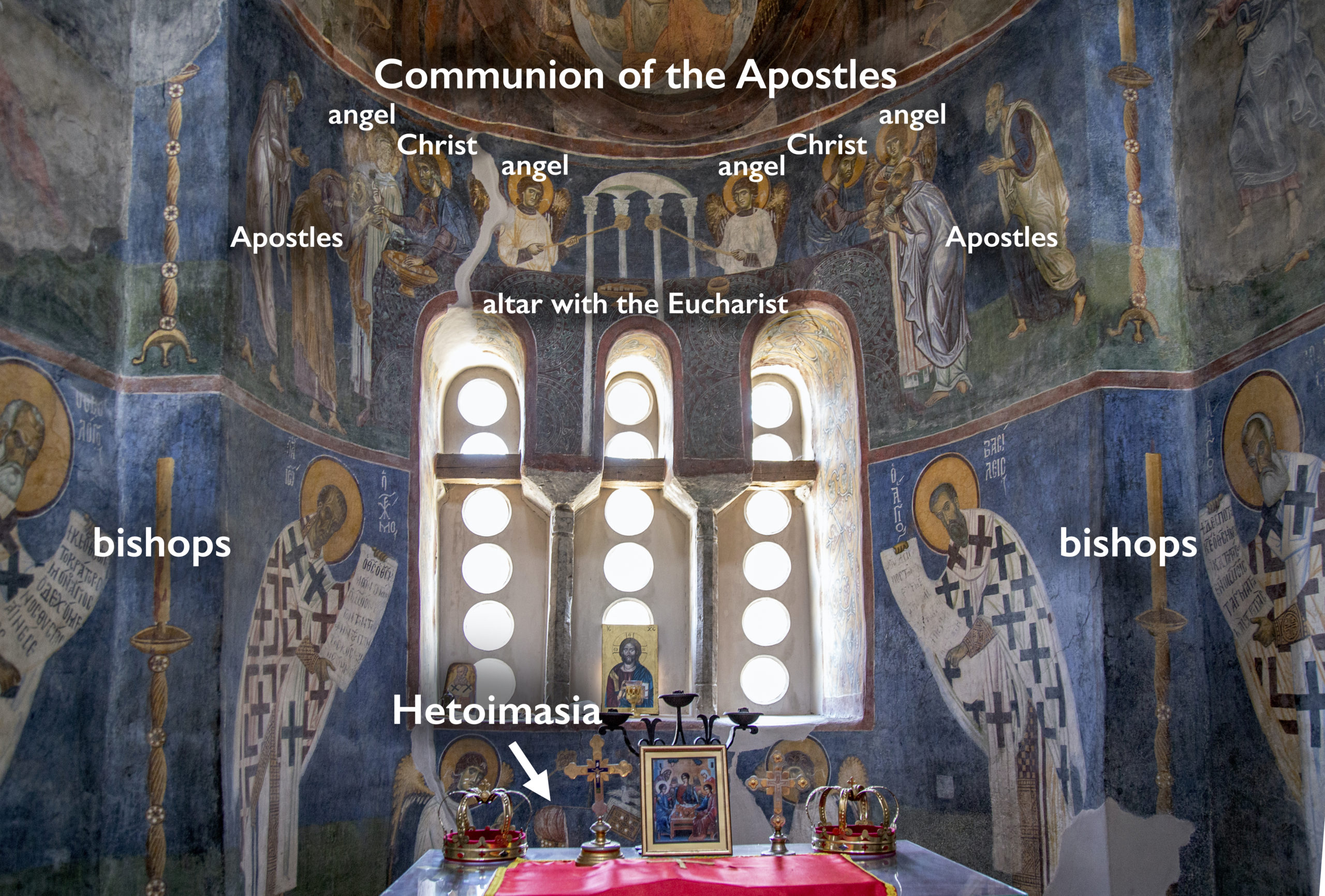
Additional resources
Sharon E. J. Gerstel, Beholding the Sacred Mysteries: Programs of the Byzantine Sanctuary (Seattle and London: College Art Association and University of Washington Press, 1999).
Sophia Kalopissi-Verti, “The Proskynetaria of the Templon and Narthex: Form, Imagery, Spatial Connections, and Reception,” in Sharon E. J. Gerstel, ed., Thresholds of the Sacred: Architectural, Art Historical, Liturgical, and Theological Perspectives on Religious Screens, East and West (Washington, D.C.: Dumbarton Oaks, 2006), 197–132.
Robert G. Ousterhout, Eastern Medieval Architecture: The Building Traditions of Byzantium and Neighboring Lands (Oxford: Oxford University Press, 2019).
Ida Sinkević, The Church of St. Panteleimon at Nerezi: Architecture, Programme, Patron (Wiesbaden: Reichert, 2000).
